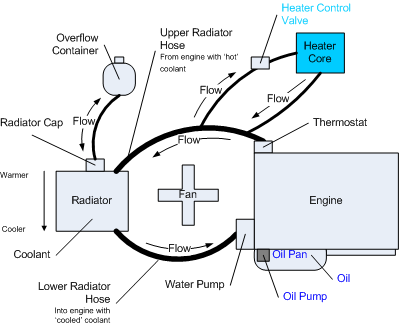Cooling System Overview
Introduction
 One of the by-products of combustion and metal on metal movement is heat.
Unfortunately, too much heat can cause metals to expand and either melt or cause high tolerance engines to have additional friction.
Clearly, engines need to manage heat generated by the rubbing of metal components together and the combustion process.
One of the by-products of combustion and metal on metal movement is heat.
Unfortunately, too much heat can cause metals to expand and either melt or cause high tolerance engines to have additional friction.
Clearly, engines need to manage heat generated by the rubbing of metal components together and the combustion process.
The cooling system’s is responsible for removing unwanted excess heat from the engine. This system is comprised of three systems:
- Cooling Fan(s)
- Lubrication System
- Cooling system
Case study about a Civic overheating
Cooling Fans
Most people would not call out Cooling Fans as a separate system. I would agree.
But, I wanted to separate them so that it can be noted that sometimes they are autonomous or controlled by the ECU.
The classic fan is spun by the crankshaft pulley via a belt.
It contains a clutch that engages when a preset temperature is reached.
In most cases, the radiator is front of the fan.
Therefore, when fan clutch engages, allowing the crank pulley to spin the fan, air is pulled through the radiator and then over the engine.
So, the fan helps the radiator and the engine block dissipate heat by moving air through and past them.
Most modern cars leverage electric fans.
These fans tend to be computer controlled.
They also allow cooling to continue after the engine is off, work well with horizontally mounted engines, and reduce parasitic horsepower loss.
Lubrication System
Many times the lubrication system is not considered part of the cooling system. In my opinion, it is part of this system.
It first lubricates all metal components touching, thereby reducing heat caused by friction.
Secondly, as the oil passes through the engine block, it is drawing the heat from the block.
When it reaches the oil pan, it dissipates its heat.
In some high performance cars, an additional oil cooler is installed to help dissipate this heat.
Cooling system
The following is a description of a typical cooling system used on most cars.
Please use this as a reference but always research the car you are about to work on to determine any implementation nuances.
Basically, a water pump pushes coolant up through the engine block.
The coolant, which has a high boiling point due to the chemicals added to distilled water, pulls heat from the block since it is cooler than the block.
If the thermostat, which is valve set to open at a specific temperature, e.g. 180 degrees Fahrenheit, opens, coolant then enters the top of the radiator.
The coolant flows down the radiator, which is comprised of fine fins/passages that allows heat from the coolant to be transferred to passing air.
This action reduces the temperature of the coolant allowing it to be again extract heat from the engine.
As it reaches the bottom, it is pumped back into the engine via the water pump.
From here, the process starts all over again.
Related Videos
 One of the by-products of combustion and metal on metal movement is heat.
Unfortunately, too much heat can cause metals to expand and either melt or cause high tolerance engines to have additional friction.
Clearly, engines need to manage heat generated by the rubbing of metal components together and the combustion process.
One of the by-products of combustion and metal on metal movement is heat.
Unfortunately, too much heat can cause metals to expand and either melt or cause high tolerance engines to have additional friction.
Clearly, engines need to manage heat generated by the rubbing of metal components together and the combustion process.
 GeekDIYMechanic - Cooling System Overview
GeekDIYMechanic - Cooling System Overview